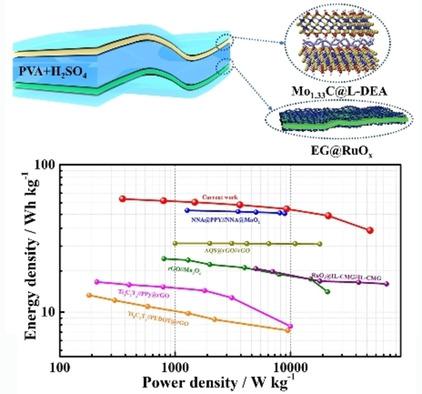当前位置:
X-MOL 学术
›
Batteries Supercaps
›
论文详情
Our official English website, www.x-mol.net, welcomes your
feedback! (Note: you will need to create a separate account there.)
Flexible Solid‐State Asymmetric Supercapacitors with Enhanced Performance Enabled by Free‐Standing MXene−Biopolymer Nanocomposites and Hierarchical Graphene−RuOx Paper Electrodes
Batteries & Supercaps ( IF 5.1 ) Pub Date : 2020-04-12 , DOI: 10.1002/batt.202000044 Leiqiang Qin 1 , Quanzheng Tao 1 , Lianlian Liu 1 , Jianxia Jiang 1, 2 , Xianjie Liu 3 , Mats Fahlman 3, 4 , Lintao Hou 2 , Johanna Rosen 1 , Fengling Zhang 1, 2
Batteries & Supercaps ( IF 5.1 ) Pub Date : 2020-04-12 , DOI: 10.1002/batt.202000044 Leiqiang Qin 1 , Quanzheng Tao 1 , Lianlian Liu 1 , Jianxia Jiang 1, 2 , Xianjie Liu 3 , Mats Fahlman 3, 4 , Lintao Hou 2 , Johanna Rosen 1 , Fengling Zhang 1, 2
Affiliation

|
Two‐dimensional (2D) transition metal carbides and carbonitrides, called MXenes, with metallic conductivity and hydrophilic surfaces, show great promise as electrode materials for supercapacitors. A major drawback of 2D nanomaterials is the re‐stacking of the nanosheets, which prevents full utilization of surface area and blocks the access of the electrolyte. In this study, a free‐standing nanocomposite paper electrode is realized by combining Mo1.33C MXene and positively charged biopolymer lignin (the second most abundant biopolymer in nature, L‐DEA). The self‐assembled layered architecture with alternating polymer and MXene flakes increases the interlayer space to promote ion transport, and with combining charge storage capability of the lignin derivative and MXene in an interpenetrating MXene/L‐DEA nanocomposite, which offers an impressive capacitance of 503.7 F g−1. Moreover, we demonstrate flexible solid‐state asymmetric supercapacitors (ASCs) using Mo1.33C@L‐DEA as the negative electrode and electrochemically exfoliated graphene with ruthenium oxide (EG@RuOx ) as the positive electrode. This asymmetric device operates at a voltage window of 1.35 V, which is about two times wider than that of a symmetric Mo1.33C@L‐DEA based supercapacitor. Finally, the ASCs can deliver an energy density of 51.9 Wh kg−1 at a power density of 338.5 W kg−1, with 86 % capacitance retention after 10000 charge‐discharge cycles.
中文翻译:

自由式MXene生物聚合物纳米复合材料和分层石墨烯RuOx纸电极可实现具有增强性能的柔性固态不对称超级电容器
具有金属导电性和亲水性表面的二维(2D)过渡金属碳化物和碳氮化物,称为MXenes,具有作为超级电容器电极材料的广阔前景。二维纳米材料的主要缺点是纳米片的重新堆叠,这会阻止表面积的充分利用并阻止电解质的进入。在这项研究中,通过结合Mo 1.33实现了独立的纳米复合纸电极C MXene和带正电的生物聚合物木质素(自然第二丰富的生物聚合物,L-DEA)。具有交替的聚合物和MXene薄片的自组装分层体系结构增加了层间空间以促进离子传输,并在互穿的MXene / L-DEA纳米复合材料中结合了木质素衍生物和MXene的电荷存储能力,可提供令人印象深刻的503.7电容F g -1。此外,我们演示了使用Mo 1.33 C @ L-DEA作为负极并使用氧化钌电化学剥离石墨烯(EG @ RuO x)的柔性固态不对称超级电容器(ASC))作为正极。这种不对称器件的工作电压窗口为1.35 V,这是基于对称Mo 1.33 C @ L-DEA的超级电容器的两倍。最后,ASC可以在338.5 W kg -1的功率密度下提供51.9 Wh kg -1的能量密度,在10000次充放电循环后电容保持率达86%。
更新日期:2020-04-12
中文翻译:

自由式MXene生物聚合物纳米复合材料和分层石墨烯RuOx纸电极可实现具有增强性能的柔性固态不对称超级电容器
具有金属导电性和亲水性表面的二维(2D)过渡金属碳化物和碳氮化物,称为MXenes,具有作为超级电容器电极材料的广阔前景。二维纳米材料的主要缺点是纳米片的重新堆叠,这会阻止表面积的充分利用并阻止电解质的进入。在这项研究中,通过结合Mo 1.33实现了独立的纳米复合纸电极C MXene和带正电的生物聚合物木质素(自然第二丰富的生物聚合物,L-DEA)。具有交替的聚合物和MXene薄片的自组装分层体系结构增加了层间空间以促进离子传输,并在互穿的MXene / L-DEA纳米复合材料中结合了木质素衍生物和MXene的电荷存储能力,可提供令人印象深刻的503.7电容F g -1。此外,我们演示了使用Mo 1.33 C @ L-DEA作为负极并使用氧化钌电化学剥离石墨烯(EG @ RuO x)的柔性固态不对称超级电容器(ASC))作为正极。这种不对称器件的工作电压窗口为1.35 V,这是基于对称Mo 1.33 C @ L-DEA的超级电容器的两倍。最后,ASC可以在338.5 W kg -1的功率密度下提供51.9 Wh kg -1的能量密度,在10000次充放电循环后电容保持率达86%。











































 京公网安备 11010802027423号
京公网安备 11010802027423号